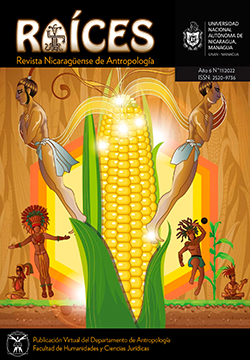El color del maíz: Gastronomía azuaya a través de la literatura entre lo tradicional y lo contemporáneo
DOI:
https://doi.org/10.5377/raices.v6i11.14473Palabras clave:
Azuay, literatura, historia, gastronomía, utensilios prehispánicosResumen
En la obra literaria Los hijos del novelista Alfonso Cuesta y Cuesta se ven representadas las costumbres y tradiciones de las poblaciones del Austro ecuatoriano durante el siglo XX. En este sentido, este artículo ha buscado exponer los contextos gastronómicos presentes en la obra, los que evidencian la cotidianidad de la ruralidad, sector donde actualmente se mantienen prácticas milenarias en cuanto a la preparación de alimentos como el maíz, el fréjol, la papa, la caña, etc. Además del uso de utensilios como las piedras de moler, las tinajas, la tulpa, que poseen una carga simbólica, y están presentes en estos pueblos. En este sentido, se aplicó el método de análisis de contenido que sirvió para exponer elementos gastronómicos presentes en la obra, que han sido contextualizados y respaldados con fuentes documentales, y a través del registro fotográfi co que refleja la realidad social del sector rural contemporáneo. Desde esta perspectiva, tendremos como resultado que las tradiciones culinarias en el Azuay, han sufrido cambios considerables debido a la vida acelerada propia del sistema moderno, optando por alimentos rápidos de preparar, perdiendo ciertas prácticas gastronómicas tradicionales. Sin embargo, se ha venido revalorizando estos saberes y prácticas por grupos independientes y políticos, a través del registro mediante la publicación de libros, artículos, fotografías, eventos, etc. llevando a cabo programas que dotan de certifi caciones para los portadores de estas prácticas denominadas ancestrales.
Descargas
473
Citas
Monge, E. (2015). Deleite al estilo ancestral. Kalpana, 13 .18-27. URL: https://dialnet.unirioja.es/ servlet/articulo?codigo=5877892.
Mora. C. (2018) Levantamiento del Patrimonio culinario de las preparaciones tradicionales de la localidad de Tulcán. [Tesis de Pregrado, Universidad de las Américas]. https://dspace.udla.edu.ec/handle/33000/9154.
Obando, P. (2010) La panela, valor nutricional y su importancia en la gastronomía. [Tesis de Pregrado, Universidad Técnica del Norte]. http://repositorio.utn.edu.ec/bitstream/123456789/2247/2/ARTICULO%20CIENTIFICO%20PANELA.pdf.
Pardos, B. (2016). Vinos que recuperan el sabor de su tierra. Sapiens. URL: https://umhsapiens. com/vinos-que-recuperan-el-sabor-de-su-tierra/.
Salazar, Y. (2015). El género novelístico en la literatura ecuatoriana. Univeristas, XIII (23),183-203. URL: https://universitas.ups.edu.ec/index.php/universitas/article/view/23.2015.09.
Sivaraman, S. (Ed.). (2018). Los Alimentos como Medicina y la Cocina como Farmacia. Editores del Austro.
Vera, D. (11 de enero de 2015). La panela, una tradición que se mantiene en Yunguilla. El telégrafo. https://www.eltelegrafo.com.ec/noticias/buen/1/la-panela-una-tradicion-que-se-mantiene-enyunguilla.
White, H. (2010). Ficción Histórica, historia fi ccional y realidad histórica. Prometeo Libros. URL: https://es.scribd.com/doc/141216563/Hayden-White-Ficcion-historica-historia-ficcional-y-realidad-historica
Descargas
Publicado
Cómo citar
Número
Sección
Licencia
Derechos de autor 2022 © Universidad Nacional Autónoma de Nicaragua, Managua, UNAN-Managua

Esta obra está bajo una licencia internacional Creative Commons Atribución-NoComercial-CompartirIgual 4.0.
Esta licencia permite a los reutilizadores distribuir, remezclar, adaptar y desarrollar el material en cualquier medio o formato únicamente con fines no comerciales, y siempre y cuando se otorgue la atribución al creador. Si remezcla, adapta o construye sobre el material, debe licenciar el material modificado bajo términos idénticos.




